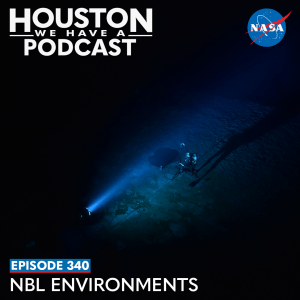
From Earth orbit to the Moon and Mars, explore the world of human spaceflight with NASA each week on the official podcast of the Johnson Space Center in Houston, Texas. Listen to in-depth conversations with the astronauts, scientists and engineers who make it possible.
On episode 340, an engineer at the Neutral Buoyancy Laboratory discusses how environmental effects help make spacewalk training more realistic in the 40-foot-deep pool. This episode was recorded on April 11, 2024.

Transcript
Host (Dane Turner): Houston, we have a podcast! Welcome to the official podcast of the NASA Johnson Space Center, Episode 340, “NBL Environments.” I’m Dane Turner and I’ll be your host today. On this podcast, we bring in the experts, scientists, engineers, and astronauts, all to let you know what’s going on in the world of human spaceflight and more. The Neutral Buoyancy Lab, or NBL, at the Sonny Carter Training Facility is the premier place to train for spacewalks. Probably the most impressive feature here is the giant pool that measures 102-feet wide, 202-feet long and 40-foot deep, and is filled with 6.2 million gallons of water. Inside the pool is a mockup of the exterior of the International Space Station, as well as an area with simulated lunar regolith to allow for Moonwalk training.
The NBL is also very useful for training at the surface of the water. They can simulate operations like water landing, recovery, and egress. At NASA, it’s “train like you fly.” So when it comes to training for different operations, there’s a need to simulate various environmental factors as well. Things like waves, wind, rain, and even lighting conditions create challenges that astronauts, engineers, and recovery teams must overcome and need to be prepared for. And when it comes to making sure the NBL can simulate these environments in as close to flight light conditions as possible, that’s where today’s guest comes in. James Shaw is an engineer and project manager at the NBL and oversees the environmental effects there. He’s here to tell us all about what they can do and how it helps make training more realistic. With that, let’s dive in.
[Music]
Host: James, thank you so much for coming on Houston We Have a Podcast today.
James Shaw: You’re very welcome. Thank you for having me.
Host: So, high level, what is the NBL?
James Shaw: The NBL is a world class training facility that focuses on post-landing recovery operations or water survival training and buoyancy offset training. The buoyancy offset training isn’t necessarily a new idea, but the NBL is a unique facility in that we can provide large enough pool so that you can do one-to-one training—one-to-one scaled training—with an ISS mock-up.
Host: So what’s buoyancy offset training?
James Shaw: We use the water, the buoyancy of the water, to lift the subject to make them either neutral or in the case of lunar EVA to make them one sixth g by offsetting their weight with buoyancy force.
Host: Okay. So you’ve got the astronaut in the suit and you’re using the buoyancy of the air in the suit to lift them up and you’re using weights in the suit to pull them down and you get them to a neutral state?
James Shaw: That’s correct. Yeah. The suit itself with the person in it is actually pretty buoyant, so we just have to strap a bunch of weight to it to begin with, even just to make it neutral. That became one of the engineering challenges for the Artemis and the lunar weigh out, because we had to strap even more weight to that subject to get them to a one sixth weigh out.
Host: It takes extra weight to do that?
James Shaw: Takes extra weight. It takes about 90 pounds of weight to make them neutral, and we want them to be about 90 to a hundred pounds negative in the pool. So yeah, we had to strap even more weight to them which we solved that problem by used in tungsten weights. The microgravity weigh out they use for ISS, they use lead weights in the pockets all over the suit to make them neutral so that they don’t float, sink, or create a moment or have any preferred orientation. For the lunar weights, we use tungsten because it’s twice as dense and we can put that extra weight on without creating this extra bulk around the suit.
Host: That’s so interesting. So what is it that you do at the NBL?
James Shaw: I’m an engineer and project manager. As an engineer, I kind of take whatever NASA’s mission is for the NBL and find a way to implement it. I’ll give you, for an example, I did some experiments to determine whether I can measure the center of gravity of a person in the pool. I didn’t really have much of a budget for that, so I just kind of pieced some parts together to put together an experiment. After that proof of concept was made, I then handed it off and became the project manager for the contractors who built the day-to-day operations, the streamlined version of my test experiment rig.
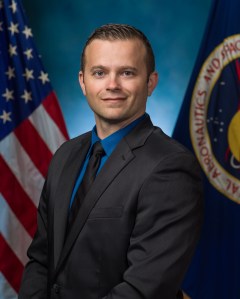
Host: That’s really neat. So how did you go about doing that? What does the rig do?
James Shaw: Well, as I said earlier, we have to offset the weight of the subject. So we have about five sixth of their weight being offset by the buoyant force. And we could just give them, you know, a bunch of weight around the ankles and say, “Hey, you’re one sixth g,” but then their center of gravity would be really low, and it really wouldn’t be representative of what they’re going to see when they’re on the lunar surface. So in order to nail down that center of gravity, we have to be able to measure their center of gravity. So, well, you ever play Wii Sports? You stand on the Wii Sports board? And you kind of shift back and forth, the little bubble moves. We created one of those in the pool. And first, just in two dimensions to make sure that we could, you know, validate that this works underwater. In order to determine the Z axis location, you have to tip them to a known angle and do a bunch of trigonometry. And once we validated that we could do that, you know, it was just a matter of building a rig so that the suit fits and that we can maintain their body posture. It’s very important if they shift in the suit, or if their legs or arms are in a different orientation, it’s going to affect the way out and change the center of gravity.
Host: So you’re finding their center of gravity through a few different positions, so then you can use some very complex math to find where that center of gravity really shifts around to.
James Shaw: Yes, yes.
Host: Interesting.
James Shaw: And we didn’t use those tungsten weights, so, well, the center of gravity is measuring too low or too high. So we moved those tungsten weights around to different pocket locations on the suits. This is all for lunar.
For ISS operations, they just use weight packs around the suit and just put the weights and the foam in to try to give the subject no preferred orientation. And that is more of an art where the lunar weigh out’s more of an art and a science. The divers are very good at what they do. They’ll take the subject down to weigh them out to ISS neutral and they just kind of let go of them and see which direction they start to float or sink and put a foam block or a lead weight in different pocket locations until they let go of them, and they’re completely neutral. And that’s where an ISS run would start.
Host: That is so fascinating. So how did you get to the NBL? What brought you to NASA?
James Shaw: Oh, how much time you got? After graduating high school, I left for the Army. I joined as an aircraft technician. I spent six years in the Army and did tours in Korea, Kuwait, Iraq, Fort Lewis. After six years, I got out, came back home to go to Georgia Southern University—I’m representing today—for my engineering degree. Towards the end of my degree, I got picked up to the Pathways Program here at JSC. During my time as a Pathways intern, I got to do rotations in ES3, EC2, CX4, and then finally the NBL. That was my last rotation before graduating.
Host: And what are those, ES and CX?
James Shaw: ES3 is the thermal branch of structures. EC2 is the design and analysis branch of thermal systems. CX4 is the operation support officer, OSO, flight controllers. And CX12 is the NBL. That was my last rotation.
Host: This is all really cool. So, you’ve told us a little bit about what the NBL does. What’s the culture like there?
James Shaw: We try to cultivate a culture of safety cause it’s not really lost on us that we operate in a facility that’s, you know, hazardous to life. So, you know, all of our procedures and day-to-day operations definitely reflect that fact that we work in a hostile environment. Second to that, we try to develop the highest fidelity training that you can get on Earth at least. We want the subjects in the suit to be completely blind to all the operations being done around them to support their training. We don’t want them to see any of the divers, you know, setting things up ahead of time. We want it to be completely invisible, everything that we do to the subject.
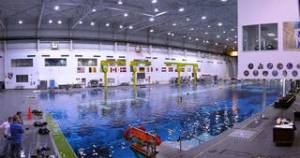
Host: So you want them completely immersed, not just in the water, but you want them immersed in—
James Shaw: In their training.
Host: Thinking they’re doing a spacewalk, right then?
James Shaw: That’s correct. Yep.
Host: That is just so fascinating. So we’ve talked about the ISS spacewalks. We’ve talked about the lunar runs that they’ve been doing on a simulated lunar surface. What other kind of trainings can you do that at the NBL?
James Shaw: We also do post-landing recovery operations and it’s water survival training. So the AOD, Aircraft Operations Directorate, their pilots come over for their, I think, five year training, recurring training, for water survival. But we also do post-landing recovery for Orion. We have a big Orion mock-up, we call it the PORT, Post Orion Recovery Trainer, if I’m not mistaken. We’ll put that in the water and put the crew in. We even have same Navy team that’s going to do the actual recovery. They’ll come to the NBL with their little zodiac boats, and we’ll let them do the training that they’re going to do post landing. The crew will get out of the vehicle, go through all their steps depending on whether they’re doing recovery or water survival. There are two different versions of there. So if they land off course, they may have to do some water survival ahead of time, before, you know, somebody gets there to recover them. So they have life rafts and things of that nature. In case they need to do some water survival training, in case they need to survive a bit before the recovery crew shows up. They also do recovery if they land in the proper location and the Navy’s there to recover them. So, they will start by doing all of their training with flat water lights on and just kind of go through the steps, you know, kind of the baseline. Then they will slowly start to introduce some of the environmental controls that we have at the NBL. We have wind, rain, waves, you know, we can even turn the lights out to simulate a night landing. You know, obviously that’s not ideal, but we want to give them worst case scenario before they land, you know, of course we’re going to hope that they land in smooth, you know, smooth seas, calm weather during the day. But we’re going to train for them worst case.
Host: So you start out, just nothing going on in the pool. You’ve got the capsule, the simulated capsule there, and you’ve got the crew members getting out of the capsule and as if they would, if everything was just fine. And then you just start adding complications, you add in some extra wind, some extra waves, some rain, turn out the lights on them?
[Laughs]
James Shaw: Yes, we do. We’ll make it as realistic as worst case scenarios. We can generate up to about a two-foot wave using the wave generators. Generate about a 45 mile an hour wind with rain and turn the lights out.
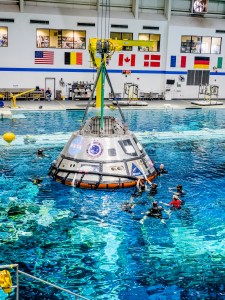
Host: How heavy can the rain be?
James Shaw: As much as a pool pump can push, that’s what we use to spray them with the rain.
Host: Wow. So what kind of thing is the wave generator?
James Shaw: The wave generator was actually an off-the-shelf item and it’s just electrically actuated sphere with a flat bottom. There’s a weight on the inside of it that just bounces up and down and causes the whole sphere to just bounce.
Host: So is this anything like, you know, someone would see in a wave pool at a theme park or something?
James Shaw: Yeah, there are several water parks that have these same systems for just recreation.
Host: Oh, interesting. And you use that in the NBL to simulate these waves for the recovery efforts?
James Shaw: Yes, we do. Yep. It’s a smart system. It’ll recognize its own reflection from the environment around it, from the pool walls, and once it recognizes its own reflection, it will meet that frequency to create a standing wave over the entire surface area of the pool.
Host: Wow, that’s really complex.
James Shaw: Yeah, it is.
Host: And then you add in the wind, you just use large fans for that?
James Shaw: Just large fans. Yep. We have one fan on the end of a jib crane, so we can swing it out over the pool to kind of reach further out. So because the wind dies off after a little bit, we have one on the pool deck. We also have rain sprayers on the end of that crane. For water survival purposes, that same crane can be used to hoist, to kind of simulate a aircraft recovery, you know, using either a basket or a strong recovery strap and point that fan straight down to simulate the rotor wash from the helicopter.
Host: Oh, wow. So you get multiple types of training out of one device.
James Shaw: Yes, sir. Yep.
Host: That’s really neat. And then we said that the rain like that’s just operated by a pool pump, so you’re pumping the pool’s water out to simulate the rain.
James Shaw: Yeah, that’s correct.
Host: That’s really cool. So you’ve got all these things for the surface operations. Is there any sort of environmental stuff you need to simulate for the ISS trainings?
James Shaw: We do control the environment inside the suit. Unlike flight, we don’t use the PLIs, we use an umbilical system. The same 46% nitrox that the divers use in the scuba tanks, we pump through the umbilicals to the suit, pressurize it to the same four point, I think it’s 4.8 PSI delta from the environment route them, the chilled water is, I think, 50 degrees or so by the time it gets to the suit to keep the subject cool inside the suit. And same communications that they’d see, we have cameras on the suits and comms with both the divers and the suited subject. There are speakers underwater so that if anyone in TCA needs to communicate with divers, they can call down and use those speakers.
Host: What’s TCA?
James Shaw: Test conductor room A.
Host: Okay.
James Shaw: It’s mini mission control at the NBL.
Host: Alright. So the people controlling the test itself, the spacewalk, can communicate with them through the umbilical?
James Shaw: That’s right.
Host: That’s really neat. Okay. So, the other thing that you guys do, there’s the lunar. What kind of environmental controls do you have there?
James Shaw: The environmental controls are the same. The one thing we do have to take into consideration is we will be at depth for a longer period of time, a deeper depth at the bottom of the pool. So, you know, oxygen toxicity is obviously one of the major concerns. So we have all the proper channels for medical to monitor for anything that could potentially happen there. For the rest of the environment, speaking for the lunar environment that we create, we wanted to create some lunar regolith so that they had some kind of collapsing sand under them while they walked around on the pool floor. We tried several different versions of sand. We wanted something that would, you know, maintain its angle when you kind of dug a trench through it. And it was really…nothing, nothing worked. So we ended up just using some pool filter sand that was low dust so that when they were walking around on the pool floor, it wouldn’t kick up a bunch of dust and make the water cloudy.
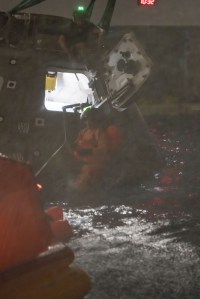
Host: So this is not something that you had to like special order, this is something that’s kind of off-the-shelf that you can get at a pool store?
James Shaw: That’s correct, yep. We tried to get something that was, you know, fancier than that. But yeah, the pool environment makes it a little difficult to work with. So we did what we could. In addition to that, we also wanted to simulate some slope angles as if they were climbing up the slope of a crater. So we had some panels manufactured that can slope up to a 20 degree angle. We put sand on one side and leave the other side hard packed surface of the panel so that they can practice walking up and down a hard packed surface. And then try again using the side that’s covered in sand and kind of get a feel what it’s like for the sand to collapse out from under them while they walk.
Host: That’s really neat. And then I’ve also seen some images down there, and we actually dove together and we’re, you know, down there for one of the tests that you guys have large rocks there?
James Shaw: That’s correct. Yep.
Host: And is that supposed to simulate like boulders on the Moon?
James Shaw: It is. We actually simulated the large boulder that we have off of the rock nickname Split Rock from the old Apollo pictures. We sent that to the manufacturer and said, “Make it look something like this.” They came back with a 25-foot long, 15-feet wide, 15-feet tall fake rock with three different platforms on it to put real rocks to take samples. We want the subject to put the suit into different configurations while taking samples. So we want them to have to reach over to take a sample from down low, take a sample mid, and another one up high. So we had those platforms installed and all the support bracing on the inside of it to, to support those heavy rocks. The real rocks—we have both fake and real rocks on the pool floor—the real rocks, we worked with the geologist here on site to go out to a rock yard and just kind of pick some rocks.
Host: And those are actual rocks. The kinds that you would find on the Moon?
James Shaw: He picked them. It was interesting to watch him walk around with his little rock hammer, and he was tapping on some rocks and like, “No, not that one. No, not that one.” Tap, tap, tap, “That one, pick that one.” And he’s going around picking rocks.
Host: Oh, wow.
[Laughs]
James Shaw: So yeah, we have those at the bottom of the pool. So subjects can practice taking samples.
Host: That’s so interesting. Now, I’ve heard that you’re also trying to simulate some of the lighting on the Moon too.
James Shaw: Yes. Yes. That actually leads back into the fake rock with the different platforms. At the South Pole of the Moon, the Sun will be at a very low angle. So the conditions we’re trying to simulate are a very bright light, very low on the horizon, creating very long, sharp shadows. Which turns out to be a little more difficult than we originally thought that would be because you basically need parallel light rays to create those types of shadows and the only way you can really do that is with a single light source. So we can create the lighting conditions, but only for a very small spot. So as the subject moves around, sometimes we have to turn the light off, let it cool down, and then turn it and turn it back on. But how that feeds back into the rock is we want them to be able to take a sample of a rock that is in a shadow while the Sun is in their face. So they got the brightness of the sun shining in their eyes while they’re trying to take a sample in darkness.
Host: Oh, interesting.
James Shaw: So we’ll turn the facility lights off so they don’t have any other light coming other than from that one under underwater light source.
Host: So they’ll be working on a rock face facing into the Sun, but the rock itself is shadowing the spot that they’re working on?
James Shaw: That’s correct, yep.
Host: So they presumably, like driving into the Sun, you know, you’re kind of blinded through the windshield, but then when you’re looking down at your console to see how fast you’re going, it’s really dark and hard to, hard to read.
James Shaw: Yep. Yep.
Host: That’s so interesting. That’s something that you wouldn’t think of, but you guys are testing for it.
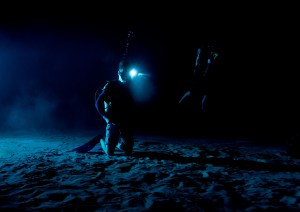
James Shaw: Yeah. Being the training facility that we are, it’s important that we stay out ahead of training needs. So, the NBL leadership is fantastic in that aspect. They see where NASA’s missions are heading and try to head them off. The whole lunar development area, you know, we jumped out ahead of Artemis before they were even requesting any of this, you know, knowing that they would eventually need it. So we have to lead the training so that by time they are ready to train, we as a facility are already prepared for them. We can’t wait till they come ask us, “Hey, can you put together a lunar training environment for us?” To start developing it, it would be too late.
Host: That’s incredible. So you guys are always anticipating these needs, looking at what the mission is going to be to work to simulate that ahead of any training that’s going on.
James Shaw: That’s correct.
Host: So you were talking about the light and you said it needs to cool down. What kind of lights are you guys using to try and simulate the Sun down there?
James Shaw: At the moment, we have a single light. From what I understand of it, it’s basically an arc welder underwater inside glass to create, you know, that level of a bright light. We only have one because we’re not entirely sure that’s going to be our permanent day-to-day operations solution for the lighting conditions. But it does work, but it’s very limited space. It’s very bright in one spot, but as soon as you step out of that light, you know, it’s kind of limited on how much we can shine at time.
Host: It’s got very narrow range. So we were talking about the safety culture at the NBL, and when you’re, I assume, using very hot lights underwater, that that’s a very, you know, you need to be very safety conscious doing that. And when you’re working with hammers and chisels around space suits, I assume you need to be very safety conscious around that. So what kind of other safety things do you need to really be conscious of as you’re doing these things and trying to simulate these things?
James Shaw: That’s actually a little difficult to answer because each training event or testing event that comes in is almost entirely unique to itself. So we go through our safety process to look at everything from every perspective so that we are prepared for, you know, that specific event. For the lunar, you know, we, we’ve already gone through test readiness reviews for use of the suit, use of the 46% breathing gas underwater at that depth for that length of time. Like I said, it’s just difficult to answer that because each event has its own challenges. And, you know, we try to address those challenges as thoroughly as possible, which is why the NBL has such a fantastic safety record.
Host: So you guys are not only thinking ahead to all the potential training things, but you’re also working through everything safety wise you can possibly think of to make sure everything is as safe as possible as these astronauts are training for it. So why do you go through all these great lengths to try and simulate, you know, these different environments for the trainings? Why is that important?
James Shaw: Because we’d like the crew to be as prepared as possible. And the best way to do that is with as a high-fidelity training environment as possible. The NBL is just a, you know, one piece of the puzzle when it comes to training for ISS operations. There’s other facilities around JSC that the crew kind of pick from. You know, each facility has its benefits and drawbacks. So, you know, while they’re training at the NBL, we tell them to focus on where they are on the spacecraft as they’re translating from one location to another, translating with their tools. They get to practice working with each other, dropping tethers in locations. There are some drawbacks in that the viscosity of the water slows them down. That’s always the biggest feedback we get when crew coming back from station after doing a spacewalk. You know, what’s the biggest difference between NBL and flight is the viscosity of the water.
Host: You got the water drag.
James Shaw: Right. So, I would imagine the lunar is going to be very similar to that, where the NBL is a piece of their training, because other environments do some things better than the NBL. But we can provide the crew working together to set up science stations, take rock samples, and we can also have them walk up and down a slope. We can have them sit in a lunar terrain vehicle eventually, hopefully. So each facility is going to have its own unique benefits to crew training cause we really can’t simulate that environment here on Earth perfectly. And even, you know, we still do the absolute best we can to provide them with the highest fidelity training that we, you know, think of. But we really won’t know how that training relates to flight until someone comes back from the Moon and gives us some feedback. So when they come back, you know, we are immediately going to hit them with a bunch of questions, you know, how was this, how was this, how was this? So that we can develop our training and modify it to, to meet, you know, what it was actually like on flight.
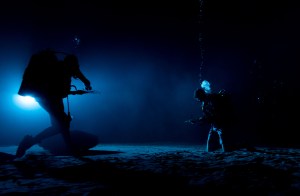
Host: That is so cool. And you guys get a lot of feedback from the astronauts after every ISS mission as well.
James Shaw: Absolutely. Yeah.
Host: I know you guys are very, the NBL and the astronauts are very tight. They talk to each other a lot and, and you guys develop a lot of relationships with these astronauts throughout all the training.
James Shaw: Absolutely. Yeah.
Host: That’s great that you guys get that feedback directly from them.
James Shaw: I think Victor once said that the NBL was his favorite place and that, you know, if he’s not at his desk, he’s here at the NBL. So, we put a desk out on the pool deck for him.
Host: He has his own desk there?
James Shaw: It was just a joke. We put a desk out on the pool deck with a little sign that says, “pool boss” with his name and filing cabinet and stuff.
Host: That’s fantastic. So can you take us through an example of like a day of training? What does it take to set all this up and then what do you guys do going through the day?
James Shaw: So I guess to start with, you know, we have to get a request for use of the facility and especially the ISS that comes from CX3 that comes to us and say, “We want to do this training.” So ahead of time, we go ahead and start planning out the configuration of the mockups underwater so that when they show up, the mockups are in the proper configuration. So when they’re translating around, everything’s where it’s supposed to be. The day of an event, we have a suit lab at the NBL, the suit lab will bring out the suit that was specifically built for those subjects. They’ll attach the hard upper torso of the suit to the dawning stand. The crew will come out and they will put the lower torso assembly on, the space pants. They’ll put the space pants on, and then climb up into the hard upper torso while it’s still attached to the dawning stand. Somebody will run the umbilicals from our environmental control system over to the PLIs is just kind of volumetric mockup with some of our ECS systems inside. So the umbilical attaches to that, so we can flow that breathing gas and chilled water and communications. Once the subject is in the hard upper torso, they’ll connect the lower torso assembly and put the gloves, the helmet on, do pressure checks, communications checks, flow for the water. Once everything is good to go and all leak checks are done, they will use one of the cranes to pick that whole awning stand up and put it in the water.
Host: But with both the astronauts on it?
James Shaw: With both the astronauts on it, yep. So that they don’t have to, you know, have to walk themselves into the pool. Once they’re in the water, the divers will take over. Each one of the crew have four assigned divers, two safety divers, a utility diver, and a float camera diver. The safety divers are exactly that. Their purpose is to just keep that crew member safe the whole time they’re in the water. The utility diver just kind of does whatever the subjects need. I’ll give you a good, for instance, the pistol grip tool that they use in the NBL, the functional version—
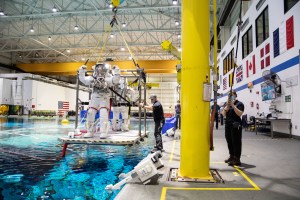
Host: That is the drill, right?
James Shaw: The space drill. The functioning version of it, we can’t make it neutral without putting a bunch of bulky foam on it. So they’ll translate to a location using a lo-fi neutral version. So it floats around like it would in space. And once they get to that location, they go to use the pistol grip tool. Our utility diver will be there to swap it out with a functioning version. It’s called a hot swap. So as soon as they go to reach for that tool to use it, the diver will be there to swap it out with them.
Host: So they’ll have just a plastic shape of the tool on them to move to the work site. Then once they get to the work site, your utility diver will swap out the plastic one for the metal one or whatever you have down there that actually works.
James Shaw: Yep. And then as soon as they get finished using it, that diver again will hot swap them and take the heavy version, the working version, and replace it with the low-fi neutral version. And then the flow camera divers exactly that. As TC, the test conductors call down, “Hey, can I get a view from over here, from over here?” Because we don’t just do training. We do testing and procedure development as well. Like the alpha magnetic spectrometer, the repairs for that were developed and then brought to the NBL to test those developed steps. And they would go through and check the list and see, okay, well let’s flip this around. Let’s change this, let’s change this.
Host: This didn’t work, so let’s try something different.
James Shaw: Yep. So we do development work too. So if their you know, TC calls down, they’re doing development work, they need to see from over here, you know, they might need to see the hardware more than they’re seeing what the subject’s doing at that moment.
Host: Right. Okay. And that person has a camera in a housing that’s good for underwater. And so they can just get in where they need to be to be able to see what the test connector needs.
James Shaw: Yep and for safety purposes, that float camera diver also can focus on the subject’s face to see, so the test directors, which are NBL personnel. So the test directors can see the condition of the subject. You know, if they’re conscious, they’re unconscious, if they’re seizing, anything going wrong, you can see their face.
Host: Oh, for like health and safety checks.
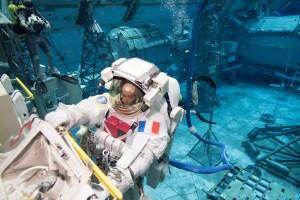
James Shaw: Health and safety checks. That’s right. Yep.
Host: Oh, interesting.
James Shaw: The float camera diver serves that purpose, too.
Host: Okay. Would they like float over there to see the person’s face when they’re just talking to the test conductor sometimes?
James Shaw: If test conductor requests, or if the test director requests, if the test director has a suspicion something’s not right, they can use the same comm system, say, “Hey, float camera diver. Can I get a view from of the subject’s face?” In an emergency, that’s actually part of our procedure as the float camera divers keep that camera focused on the subject’s face the whole way out of the pool.
Host: Okay. So that way you can see as things are developing, what’s going on down there. That’s really neat that, that you’ve got this whole team of divers around to just do everything needed in the water for these tests.
James Shaw: Yep. Yep.
Host: So we just talked about what you guys do for the ISS tests. What about for the surface testing?
James Shaw: The lunar surface testing?
Host: Well, the testing on the surface of the water. What does the day look like for that?
James Shaw: Those vary depending on what the requests for training are for that day. Sometimes we have to work with, I think it’s CX4 that makes those requests. We work with them and sometimes we have to work with the Navy if the Navy are coming in to participate in the training. So we’ll have DOD personnel in the day of a run. I guess we’ll start that morning by putting the vehicle, the mockup of the Orion capsule, in the water. Then we’ll do systems checks on the wave generator and the fans and the rain, get all that set up. The pool water level has to be lowered by about three inches in order for us to make waves without splashing over the sides. So as some of the facility personnel are there preparing the wave generator, the other environmental systems and lowering the water level. Once that’s complete, you know, then the subjects start to show up and then the DOD personnel start to show up. When they are ready, we have a floating dock that’s in the shape of a U that goes around the vehicle when it’s in the water. So they can easily get in and out of the vehicle without a whole lot of, you know, difficulty. We’ll get them into the vehicle and then use the overhead crane to pull the Orion mock-up out into the middle of the pool.
They’ll start the day by going through their procedures with flat water, no wind, no rain lights on, just to kind of test run before we start throwing the difficult stuff at them. So they’ll go through that, make sure everything, you know, all their equipment is working properly, make sure they follow all their procedures and they’re kind of refreshed on it. Then we will do the wind, rain, and waves. And then sometimes they’ll do it a third time with the lights out. The divers that are in the water and all the support personnel, each one of them have a glow stick or a chem light on their head so we can track of them even with the lights out. So even then, we’re, you know, taking safety into consideration.
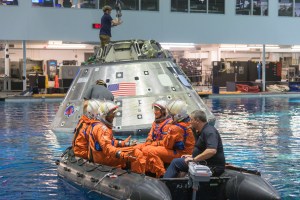
If there is a possibility of a subject being submerged and, you know, not being able to surface, we’ll have support divers in the water just in case. So we’ll usually have support divers, we’ll have lifeguards on duty, medical will be there through this entire thing. And what I was mentioning earlier is we want all this to be completely invisible to the crew so that, you know, all of these support staff, they’ll keep their distance from the vehicle in case if they do see anything as unsafe for an emergency, anybody at any time can call an all stop and we can turn the lights back on and address whatever safety concerns are going on. So, I hope I answered, did I answer your question?
Host: Yeah. That, that’s great. I have a couple follow up questions. So you mentioned the glow sticks that all the divers have. Do you guys use those for the lunar runs that are you know, dark with the one light as well?
James Shaw: Since it’s a lunar run and it’s in the bottom of the pool, each diver has their own flashlight. They have their own dive light.
Host: Okay. That’s really cool.
James Shaw: Yeah. So once the lights go out on the facility, the divers use their own lights. Of course, you’re told to kind of keep it away from the subjects while they’re conducting their training so you’re not shining the flashlight at them. But if you need to do any swimming around, you have a light there to make sure that you can, you can get there safely without bumping into, you know, a bunch of mock-up stuff you have in the water.
Host: There’s a lot of stuff in the water.
James Shaw: There is, yeah.
Host: And then you said that you have to lower the pool level by three inches to use the wave generator. Is there any concern of the mockups being, you know, sloshed around when you’re using the waves?
James Shaw: Yes. That’s why we only lower the water level by three inches. When we were originally developing the system, we lowered it by a foot so we can generate the larger waves. But the mockups definitely took the brunt of the wave energy. So we learned our lesson from that. So we don’t lower the water level that, that far anymore. If anybody requests for larger waves, we can remove some of the mock-ups as needed. That’s something that would have to be a, you know, long lead request to get those mockups out of the way ahead of time. But we can still generate those waves with the proper requests and scheduling.
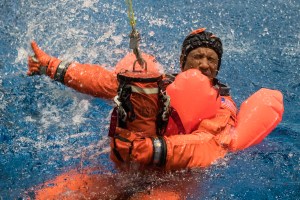
Host: Wow. So you guys have a lot of different capabilities there. It can take some work to get some of them in place, but you guys can do a lot of really cool and interesting things there.
James Shaw: Absolutely.
Host: Do you get to participate in any of the training that’s going on?
James Shaw: Sometimes, not necessarily in the suit. I have been in the suit cause every now and then we do egress training, which it’s training for the divers to get a subject out of the pool in an emergency. So when we do that, we usually put one of our own guys in the suit. So I got to do that once. So I have gotten to be the unconscious dummy in the suit being pulled out of the pool. So I have gotten to do that. Some of the hardware that I help design or some of the tests that take place, if I have a hand in it, then I do get to dive and, you know, observe to make sure that whatever I designed or whatever procedures are being done properly. And it’s functioning as designed. So, yeah, I guess I do get to do some of it. I have done the water survival training too.
Host: Oh really?
James Shaw: Since I was the one that developed the environmental systems for the wind, rain, and waves, I got to do the, the water survival training to see what it was like before and after implementation of all these environmental systems.
Host: That’s so cool. So you were in the Orion capsule and you had to get out?
James Shaw: I was just doing the standard water survival, so it was parachute landing. So they drop you from a crane into the pool at a pace that you would expect coming down from a parachute. Once you hit the water, your life vest will inflate and then they put you under a parachute. You practice getting out from under a parachute in case it lands on you. We have a winch that’ll pull you across the pool at a pace that you would expect if you were getting drug through the water by your parachute. So they’ll drag you through the water with your parachute, you got to release the parachute harness. They’ll have you practice getting in and out of a life raft. And then the final one is recovery. They’ll have you use the three different recovery devices, the forest penetrator, and the basket.
Host: Oh, wow. For the helicopter.
James Shaw: Helicopter. Yep. Yep.
Host: Wow. So you have to go through all that. That that sounds really cool.
James Shaw: It was really cool. That was really cool. It was good training.
Host: That’s definitely a perk of job right there. Getting to test these things out and go diving all the time.
James Shaw: It’s not every day you get lifted by a crane over a pool and dropped into it.
[Laughs]
Host: That sounds pretty unique.
James Shaw: Yeah.
Host: So, you’ve got all these really cool capabilities now. What does the future look like for training at the NBL?
James Shaw: The lunar is still under development. We are still working with what space we have. The pool is, it’s very large, but it’s still limited, especially when you have a one-to-one scale ISS mockup. So we are trying to find ways to expand the lunar terrain under the ISS mockups. We also are expecting our first mockup of Gateway soon. So we we’re going to have the ISS, the Gateway mockup, and lunar terrain in the pool.
Host: So we’ll be able to test for Gateway spacewalks.
James Shaw: Right, right. We’ll be able to train for that. We’re not expecting, you know, the Gateway’s not going to be constantly crewed like the ISS. So, we’re not expecting the same level of training requirements, like the same number of training events per year. So it may be a, you know, for the next couple of weeks we’re going to take out part of the ISS mockups, put the Gateway mockups in, and do just Gateway for the next couple of weeks, and then pull them back out once we’re finished. So I guess right now we’re still considering the expansion of the lunar terrain because we’d like to open that up as best as best as we can to take advantage of as much space on the pool floor. We’re expecting the first module for Gateway, and those Gateway modules are going to keep coming in. So that’s what the future of the NBL is looking like right now is, so even with ISS deorbit on the horizon, the NBL still has a future in space EVA training.
Host: It sounds like there’s some really cool things coming up and, and you’re just going to keep expanding your lunar South Pole tests. And looking forward to seeing some photos of that lighting in there as you test some of the lunar lighting.
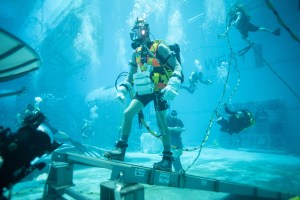
James Shaw: I don’t know that we have any coming up anytime soon. But it is still definitely on our scope. Right now, most of the runs that have been taking place have been more suit development and process development more than it has been preparation of the crew in the suit. We did do that one run, you may have seen the video for that one, NASA released it on their Twitter page, I think a while back. It was a couple years ago. It was darkened conditions. That was our first test of the lunar lighting conditions. Since then, we’ve had to focus on the suit and the processes and the EVA development, stuff like that. So the lighting has taken a backseat for the moment, but it will show back up eventually. And that is definitely going to be part of the Artemis EVA training flow.
Host: That’ll be very cool to see when you guys get that back up and running.
James Shaw: Absolutely. Yeah.
Host: So to wrap things up, how would you stress the importance of training in a variety of conditions and more specifically, the value of the NBL when it comes to astronaut training?
James Shaw: I would stress that no one facility can provide all the training needs for the either ISS micro g environment or one sixth environment. It’s still going to be a product of multiple different training facilities, including Argos, the NBL. Each one of these facilities has their benefits and their disadvantages. So while the crew is going through their training flow, each one of the facilities highlights, hey, you know, here’s what this facility is good at simulating, here’s what we’re not so good at simulating. So kind of ignore this part. Maybe take from a different training facility when you’re considering this. So the NBL definitely still serves a purpose for Artemis training just as all of our astronaut training facilities still do.
I’ll highlight one specific event on station where the crew member got water into the helmet. They were able to get back to the airlock. Because of his training at the NBL, he knew exactly where he was on station in three dimensions. He knew exactly where the handrails were that led him all the way back to the airlock. So with the water in the helmet and his eyes covered, he was able to get himself back to the airlock safely because his training at the NBL. I would imagine that level of training would probably translate to Artemis as well, because part of the planned EVA training is unconscious crew member recovery. So even on the, you know, Artemis, they’re on the lunar South Pole and one of the crew members becomes unconscious, the other crew member still has to get them back to the lander to get them back inside safely. So that type of emergency training is still going to take place at the NBL. And, you know, just speaking to, you know, their safe operations on the lunar surface, if your center of gravity is accurately measured and placed at the NBL, then you know exactly what your tip over point is when you get to the lunar surface. So I’m sure everybody has seen those videos of the Apollo astronauts tripping and falling over and stuff. So we want them to do that falling over at the NBL where we have the viscosity of the water to slow them down, where we have the support divers there to make sure that they don’t hit their helmet bubble on anything so that they can find the limits of the suit in a safe environment. So when they get to the lunar surface, they know, okay, well I can’t reach that far out to grab something or I’m going to fall over. I’m going to lose my balance. And some of the runs we’ve already done doing Lunar EVA, we’ve already seen instances where the crew fall over and that’s kind of what we’re going for. We want them to fall over in the pool before they get to the Moon, you know, for safety purposes if nothing else.
Host: That makes so much sense. And that is a fantastic thing to leave this on. James, thank you so much for coming on Houston We Have a Podcast. This was a fascinating discussion.
James Shaw: Thank you for having me. This has been great.
[Music]
Host: Thanks for listening and I hope you learn something today. For more on the NBL itself, you can check out Episode 146 from back in 2020. And if you want to find out more about what it takes to be a diver at the NBL, you can go to the NASA Johnson YouTube channel and check out Cosmic Careers: NBL Divers. Check out nasa.gov for the latest information, and you can find all of our podcast episodes as well as all the podcasts from across the agency at nasa.gov/podcasts. We’re on social media at the NASA Johnson pages of Facebook, X, and Instagram. Use #AskNASA on your favorite platform to get in contact with us and make sure to mention it’s for Houston We Have a Podcast. This episode was recorded April 11, 2024. Thanks to Will Flato, Abby Graf, Jaden Jennings, Dominique Crespo, and Gary Jordan. And of course, thanks again to James Shaw for taking the time to come on the show. Give us a rating and feedback on whatever platform you’re listening to us on and tell us what you think of our podcast. We’ll be back next week.
This is an Official NASA Podcast.


























